
|
|
'White 42' is shown as profile drawings in both the AeroDetail book (page 25, in black and white) and the AJ Press book (page 55, color drawing). I had never seen the photo that inspired these right hand views, until Peter Kormos finally found it in German Jets In WWII by Model Art from Japan.

|
Details of the location and date are lacking at the moment. My first guess is that is was photographed at Wright Field or at Freeman Field, judging from the hangar, and the American-looking serviceman. Identification of the location is the first priority: if it was photographed in the USA, there is no garantee that the various parts of this Komet actually belong together.
Ignoring the above for a moment, here are some comments. Puzzling is the light mottling, compared to the very heavy mottling seen on the left side of 'White 42' in the photos below. The mottling style of the fuselage and fin is consistent, which suggest they belong together. The vent on the extreme rear fuselage appears to of the simple bulbous type, whereas the left-side photos show the 'bulbous with a dent' type. The fin root fairing doesn't seem to belong to this aircaft. Rear-view windows are of the same type as above. The aircraft does have a MG151/20 ammo hatch. Long span trim flaps, but the wings are not necessarily original. Fuselage cross identical to photos above. No antenna mast. More insights later I hope!
There are a few photos around like the two shown below. The appeared to be related to the Merseburg photo shown in the next section, but further data was lacking. Paul L Tremblay was able to fill is some highly interesting details. Paul's father was in the 818th Engineer Aviation Battalion during WW2, and he has a companion photo to the left photo. The photo was made in Altenburg, and the Komets were later trucked to Merseburg and guarded by the 818th Engineer Aviation Battalion.

|

|
The photo below was offered on Ebay in April 2001, and was bought by Shamus Reddin of the Walter web site. He kindly scanned and sent the photo. Later it proved to be an important piece of evidence in another puzzle, that of 'White 54'. It shows six Komets, most likely captured in the Leipzig area, waiting to be trucked to a central collection point, for possible evaluation. The location is now confirmed to be Merseburg. The building to the side of the the hangar can be seen in photos from 1936, taken during a parade. That photo also shows a round clock hanging at the very corner of the hangar, and that too is (just) visible above the canopy of the second Komet from the left. Another reference is this Ju 388 photo, confirmed to have been made at Merseburg. It is shown on Christoph Vernaleken's Ju 388 website, with thanks to Bernhard Weiss of the Fliegerhorste site for spotting it. The same hangar is seen again in this Freeman Field Komet photo. Note that all Komets at Brandis were blown up by retreating troops, so the photos were definitely not made there.
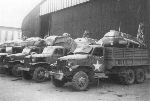
The front Komet is 'White 42', and belongs training Gruppe III/JG400. The badge is either of 13. or 14. Staffel (unfortunately this is still unclear). The aircraft number painted is another sign of it being a training aircraft. The aircraft seems to lack armament, since no gun muzzle is visible (nor a taped over one), and no weapon can be seen mounted in the wing root. It is possible that this is (or was) an early MG 151/20 equipped aircraft: if studied closely, the lower edge of the smaller MG 151/20 ammo loading panel appears to be visible; however it's no more than a vague line in the mottle pattern. The camo appears to be rather unique: it consist of mottles that are relatively light on the aircraft's centerline, and very dense on the fuselage sides. The wing root appears solidly painted. Note the many mottles on the canopy frame. The swastika is black without an outline. The Morane radio antenna is in a light color. The nose band appears to be yellow with a white edge.

Unbelievably, a photo of the right side also turned up. I'm pretty sure the swastika on the tail was removed digitally. The fuselage mottling looks about equally dense as on the left side. Although the photo is blurry, it appears that the 13. or 14. Staffel badge was applied to the right side too. The photo shows clearly that the armoured glass was fitted.
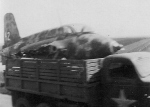
The photos below shows 'White 42' in the USA, but fitted with the tail of 'White 54' ! The location is now identified as Freeman Field; previously it was reported that it could be Wright Field, later Wright-Patterson AFB. Not surprisingly it was always assumed that this was the real 'White 54', but photos of a yet unidentified Freeman Field Komet showed that the tail of 'White 54' was used on other Komets too. This then led to a comparison of the photo below with that of 'White 42' on the truck, and the conclusion could only be that it was 'White 42' again!

|

|
The following proof of this aircraft being 'White 42' can be offered: the mottling pattern on the front fuselage and canopy frame are exactly identical, and especially noteworthy are the two very dark mottles between the wing's trailing edge and the rocket exhaust.
David E. Brown (of Experten Decals) offered further data for the mix-ups. He supplied a photo from his collection that shows one of the Merseburg Komets being loaded by crane onto a C-46, for transportation to the USA. Most pointedly, the Komet's tail is removed! This could explain the subsequent mixing of fuselages, tails and wings in the USA.
The small MG151/20 ammo loading hatch on the fuselage spine is very clearly visible in the Freeman Field photos. This identifies 'White 42' as one belonging to the first Messerschmitt production block with 3100.. Werknummern, and within this block most likely one of the first 40-50 or so. In his book 'German aircraft interiors 1935-45', author Ken Merrick supposes that the large numbers found on several training Komets are in fact the Versuchsnummer. This would make this aircraft V-42, WNr 310051, Stammkennzeichen presumably PK+QM. But I have seen no concluding proof for this theory.
The above photos are the only known photos of 'White 42' in its original paint. But 'White 42' seems to have had quite a career, as can be seen in the photos below. Because the original paint is gone, it's difficult to establish the exact identity, but the Komets shown below have so many airframe similarities with 'White 42' that I'm quite certain it is one and the same aircraft. These are the recognition features of this particular airframe.
a small MG 151/20 ammo hatch on the spine
the gun openings in the wing root are for MG 151/20, meaning they are placed lower than for the MK 108.
the Morane radio antenna behind the cockpit is missing
the first-style air scoop on the rear fuselage
the fresh air window in the canopy is open or absent
the rear view window has the forward part sheeted over
the fairings for the fuselage - vertical tail joint are absent, or a badly matching replacement is fitted
the pitot boom is missing
in many photos, wrinkle can be seen in the sheet metal above the tail wheel, on the left side
a small hatch in the vertical tail is nearly always missing
Whether the photos below are placed in chronological order is unclear.
The photographs seen below shows 'FE 495', and although it has been repainted, it shows so many similarities with 'White 42' that it is very likely that they are one and the same. It now has mottles all over the fuselage, a squadron badge with the text 'Komet' aft of it, a white swastika and 'FE 495' white.
'War Prizes' reports that FE-495 "was recorded at Wright Field on 1st August 1946, in use as a mobile display exhibit. It is believed to have been scrapped in about 1950, after use in USAF recruitment displays up to that time.". Note that the wrinkled fin tip, as seen in the Wright Field photo, is no longer visible. It's possible that the 'White 54' fin was exchanged for yet another. All photos below have in common that the rudder shows a bulge at the top.
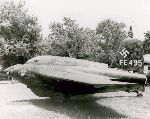
|

|

|
The aircraft shown below is most likely again 'White 42', repainted in a fairly simple camouflage scheme. The 13. or 14. Staffel badge on the nose is still retained, with a 'Komet' text that is larger than seen two photo above on this page, but in the same style. Several texts are stenciled on the aircaft; the one behind the fuselage cross appears to read 'Rocket Engine xxx'. It's unclear whether it had a swastika, the photo could be edited in that area.

|
In 2023, the following photo set turned up, showing a 'foreign aircraft exhibition' at a yet unknown location. I compared it to the Wright Field 1945 show, and the Freeman Field 1945 show, but I don't see convincing similarities. The V2 may be the most important clue: it is different from that at Wright Field show and the Freeman Field show. The Wright Field V2 one had blunt but pointed nose; the Freeman Field V2 had a pointed nose transitioning into what could be a pitot tube, or an antenna (see this shot: YouTube: Freeman Field Air Show); but the V2 shown here had a blunt nose that appears to be rounded. That shows we're seeing three different locations / shows. The Bf 109 appears to have a P-51A spinner, there's an obvious mismatch in the fuselage and spinner diameters. It could be Bf 109G-10 T2-122, but I can't find photos of T2-122 that look similar.
It is suggested this might be an exhibition at Chicago-Orchard Place, that became Chicago-O'Hare in 1949. As the webpage O'Hare Airport Predecessor explains, all foreign aircraft were shipped to Chicago for storage for future use. The fighter aircraft were stored at the 803rd Special Depot. When the Korean war came around, the majority of these aircraft were scrapped to free up hanger space. Some are buried under the runways at O'Hare. However, the buildings at Chicago-Orchard Place consisted of the former assembly line of the Douglas C-54 Skymaster, the military version of the DC4. The webpage Smithsonian National Air and Space Museum Park Ridge, IL (Orchard AFB; Orchard Place) Collection clearly shows typical factory buildings, flat-roofed hangars with transport / crane rails in the ceiling - nothing like the Komet photo. Therefore, Chicago-Orchard Place is unlikely the exhibition location.
The USAF Museum at Wright-Patterson AFB has at least one hangar that shows a similar truss structure, see for example 2010 photo that is part of the Aerial Visuals Airframe Dossier: Fisher P-75 Eagle.
The Komet pictured is the same as shown in the previous section, with the exception of a swastika that is now visible.
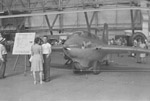
|
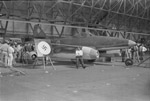
|

|

|
The most confusing part of the history of this aircraft was that is was repainted as 'FE-500' at some point in time. Whether this was an error or a deliberate action is unknown. The aircraft appears to be painted in a dark (green?) color overall. As so often with captured Komets, the gun bay covers look strange (rough?). White text stencils can be seen all over the aircraft to identify specific components. I can only read 'T2 INTELLIGENCE' beneath the 'F' of 'FE-500', 'RADIO' on the small hatch left of it. Further stencils are seen on the rear fuselage (look through the glare), elevons, skid bay, and near the cockpit.

|
Yet one more guise is known: again repainted, but without any FE codes. I'm quite sure this is the same aircraft as the fake 'FE-500'. It's missing the Morane antenna, it has the typical rear window and locally fabricated tail root fairing again, and it shows a similar buckle in the tail wheel fairing (down and rearwards from the lifting point). The pitot boom is missing like in all 'White 42' photos.
The paint scheme is completely different again, consisting of two colors in a rather strange scheme. It's painted in a dark color overall, with a very pointed triangle in a light color. In the second photo, it appears that another very pointed trianglular area was painted in the light color. Like the fake 'FE-500', it is covered with white text stencils, but they are not identical. The swastika has moved down a couple of centimeters, and the fuselage cross is different.

|

|